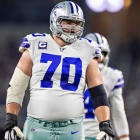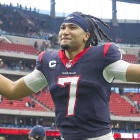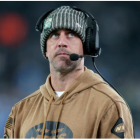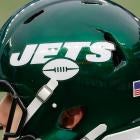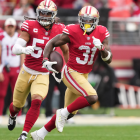The New Orleans Saints were unable to solve the Washington Redskins’ read-option offense last week, with rookie Robert Griffin III carving them up while running a system very similar to the one he did in college. League sources indicated the Rams may take a different tack with him this week than what New Orleans employed, with its defensive ends often “crashing down” on the quarterback and in essence reading every play as a run early on.
Griffin (6-2, 223), who is not an imposing physical specimen in the mold of the massive Cam Newton, could end up taking a pounding early. The intent would be to force Redskins play caller Kyle Shanahan into more of a traditional approach, and call more running plays for his backs to help protect Griffin and keep him from absorbing punishment.
Griffin is also likely to be without his top weapon -- receiver Pierre Garcon is very doubtful with a foot injury -- and the Rams believe they have the kind of cover corners who can flourish making plays on the ball if Griffin is forced to throw more downfield, and/or outside the hashmarks. Washington’s Week 1 offense was predicated on screens and quick reads as it marched on New Orleans.
St. Louis could also try to overload the weak right side of Washington’s line with numbers -- double B gap blitzes -- to marginalize Griffin's athleticism and the quick passes and speed screens that covered up the Skins' O-line deficiencies. Last week Washington ran its power stuff to the left, where tackle Trent Williams anchors things.
Even though the Rams have athletic ends who could in theory shadow Griffin and try to contain him, keep an eye out early to see if they in fact crash down. If the Redskins are able to stay in the read option and keep Griffin in that comfort zone, it could be a long day for a second straight Redskins opponent.
Mario Williams wearing a brace on wrist, but Bills believe he's fine
Mario Williams became the highest-paid defensive player in league history this offseason, when the Bills made a rare foray into the deep end of the free-agent market by giving him $50 million in guarantees. But the former Houston Texan was shut out by Jets journeyman tackle Austin Howard in Week 1, and, despite not being listed on Buffalo’s injury report, went to the trainers this week to seek an apparatus or cast to wear on his left wrist, according to sources with knowledge of the situation.
Williams did experience discomfort in his wrist at the tail end of the preseason, but medical tests did not indicate anything of note, and he continued to practice and play as he normally would, the sources said. After struggling to muster any pass rush in the lopsided loss to the Jets, Williams again expressed trouble with the wrist. Again, Williams missed no practice, the team doesn’t consider it to be an injury and there is not a sense among teammates that Williams is ailing.
Williams has told others he expects to wear a device on his wrist for 3-4 weeks, and it obviously can do no harm. What is clear is that Williams is already under fire in Buffalo, with his signing expected to quickly elevate a lagging defense and finally add some bite into what was an impotent pass rush last season. Those expectations were clearly not met in a 48-28 loss in Week 1.
The Bills are tinkering with their defensive lineup as well, with the coaches considering benching starting cornerback Leodis McKelvin for Sunday’s game against Kansas City, the sources said.
Mendenhall unlikely for regular duty until after the bye
Steelers running back Rashard Mendenhall has made a shockingly rapid recovery from season-ending knee surgery performed last December and returned to practice last week. However, according to league sources, don’t expect to see him in a game with any regularity until after Pittsburgh’s bye week.
That is the most likely date for his return, barring any setbacks. The Steelers face the Raiders next week, and the plan is to continue working Mendenhall back in practice and building his confidence and stamina. He could perhaps debut in a limited role to provide some reps, but his workload would ramp up after a bye in Week 4, with an eye toward a regular backfield rotation spot against the Eagles in Week 5.
Originally, the Steelers planned on Mendenhall opening the season on the Physically Unable To Perform list and then hoped to have his services for the playoff run in December. With so much progress already made, and Mendenhall so far ahead of schedule, they don’t want to do anything to deter the growth now.
The team is attributing his speedy recovery to his conditioning, overall athleticism and determination. The Steelers did not address the running back position in free agency, feeling good about the ability of Isaac Redman, Jonathan Dwyer and rookie Chris Rainey to fill the void until Mendenhall’s return.
Steelers linebacker James Harrison is out for Sunday’s game against the Jets, while safety Troy Polamalu is among the team’s early inactives as well. Steelers coaches are preparing as if Polamalu is out, though there remains a very, very slim chance he convinces the team in warm-ups he is well enough to dress for the game.
NFL considering idea of “officiating academy” to develop officials
The National Football League is considering the concept of creating its own “referee development academy,” a result of its current lockout of officials which could drastically change the way officials are identified, trained and ultimately hired in the future, according to a league source.
As part of commissioner Roger Goodell’s quest for innovation in all parts of the game, the league’s officiating and football operations have been studying the progress of the measures enacted with the replacement refs, all of whom have far less high-level experience than their locked-out counterparts. The NFL has taken a hands-on approach with its officials from Monday through Saturday during this labor impasse -- much more so than was the norm with the regular officials -- and anticipates maintaining some of that approach with the locked out officials as well, should the sides strike a deal. More frequent points of emphasis, quizzes and on-line curriculums for future referees would be part of the academy concept.
Through the process of training the replacements, the league has cultivated more ideas about how to train its officials and grow the pool of prospects, and the league is also intrigued by the prospect of a program to expedite the process of getting recently retired players more quickly into the ranks of NFL officials, the source said.
“We are learning a lot during this process (of fielding replacement officials),” the source said, “and we have found that you can identify and train talented people who are passionate about this job, and do it in a more expedited fashion. It doesn’t have to be the old way of taking 10-to-12 years of big-time college experience. We’ve realized through the process how to be more innovative in terms of training and development, and we’re finding that the old way to do it is not necessarily the best way.”
The source said that the idea of creating an NFL Officiating Academy has been discussed internally, and that its merits are growing. “You are anticipating the future right there,” the source said.
Of course, this comes at a time when things have grown sour with the league’s long-time officials. The sides have made no progress since holding last-ditch talks just before the start of the season, according to sources on both sides, and no new talks are planned. The league is of the mindset that the replacements will get better each week and is investing all time and energy into coaching and improving their performance from week to week. The NFL Referees Association has said repeatedly it is open and eager for new talks, but the better the performance of the replacements becomes, the more tenuous the NFLRA's leverage may be.
The NFL has also been working hard to create a spring developmental football league to replace what the league’s branch in Europe used to accomplish, and that effort could go hand-in-hand with the development of officials, offering a proving ground of sorts. In the past, many players have approached the NFL about wanting to transition from the playing field into officiating, but the overwhelming majority have been turned off by the standard route of more than a decade spent working college games.
But given the players' knowledge of the game and superior physical conditioning, and with the improvement that the replacement officials have made in a short time, many in a position of influence in the league believe that the window for a qualified ex-player to make the jump could be reduced to 3-4 years.
“This would give us a tremendous opportunity to expand the talent pool,” the source said. “We could create a fast track, working high school and college games, following our program, and accelerate the process.”
Regardless of the outcome in the negotiations with the locked out officials, there are certain developments in terms of the degree of contact between the league office and on-field staff that the NFL wants to see continue, the source said. There has been increased direct daily contact between officiating supervisors and the crews, more conference calls and more tests and tutorials. Meanwhile, there has been virtually no pushback from the replacements on this program, which the source said is a change from the past, when regular officials cited the requirements of their full-time jobs in resisting the more aggressive learning measures.
“This may be something we are insistent on moving forward,” the source said of the more direct and regular contact, which would allow the league more control of the process and greater access to its officials on non-game days.
No progress on HGH testing; None anticipated for 2012
The NFL and NFLPA have made no progress on the issue of HGH testing, according to multiple sources from both sides. The league and union have had difficulty agreeing to even the most tangential components of a potential agreement, and neither side has much confidence in a deal coming together this season.
The sides have exchanged letters related to the issue, but have not had substantive talks on HGH testing since June. No further talks are scheduled at this point, and, given all the complexities and challenges that come with this -– including possibly identifying or empowering a mutually agreed upon third-party to oversee and implement the testing -- this process remains far from a conclusion.
The current collective bargaining agreement did not include details on how to handle the testing and while some suggested an agreement might come together before the start of 2012 season, testing won't come until at least 2013, if not longer.
The differences run so deep that, according to sources, the sides have often been unable to agree on the merits of testing in other sports, how effective those tests are, what precise test would be administered to NFL players. The scale of the testing, how “random” it would be, etc, all remain as significant hurdles to overcome at this point.
Given the climate that exists between the NFL and NFLPA, and the various lawsuits either ongoing or pending, league insiders believe it may ultimately take major trade-offs at the bargaining table -- i.e. bartering for limitations on the powers of the commissioner, or making changes to the existing collective bargaining agreement -- before we actually see HGH testing in the NFL.
Follow Jason LaCanfora on Twitter @JasonLaCanfora.










